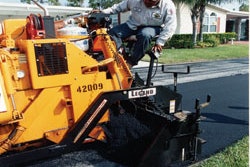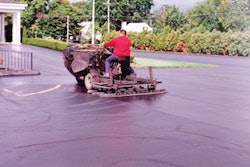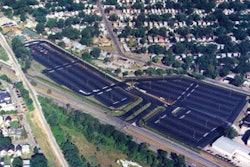
There is a lot of competition in the sealcoating industry, and you need to set yourself above it in order to attract the driveway and parking lot jobs you want. National Pavement Expo in Atlanta this February offered a couple seminars for the sealcoater looking to take his professionalism to the next level. "Troubleshooting Sealcoating on the Job" by David Lewis of Moore Seal Inc. and "Successful Sealcoating Made Simple" by The Pavement Pros, Mike LaForge and Rick Roscoe, offered several tips for ensuring a professional sealcoating job. Here are just a few.
- Prepare the pavement. The area to be sealcoated needs to be clean in order to get the best adhesion possible. Sealcoat will not stick to dirt and oil spots, so take the time to clean off a driveway, including removing any vegetation, and prime any oil or fuel spots on the asphalt.
- Expose the driveway edge. Use a power broom to push back the grass around a driveway to expose the edge of the asphalt slab without using a weed trimmer.
- Repair cracks. Crackfilling the lot or driveway you're about to seal will help your customer's pavement last longer, and make your job look professional longer.
- Prepare for breakdowns. Keep extra tips, ball valves, hose clamps, brushes, handles, and an extra filter pot on your truck.
- Inspect your hoses for wear daily. Dragging hoses along the asphalt can cause damage and eventually lead them to burst.
- Advise customers about care. There are a few substances you need to warn your customers about before sealcoating. Lawn fertilizer caught in asphalt cracks can create brown "leopard spots" on a newly sealcoated pavement. To avoid a call back, make sure it has rained at least once or that the driveway has been pressure washed since your customer's last fertilizer application before sealcoating. Also, Armor All will leave marks on sealcoat, so tell your customers to avoid applying it directly to tires on their driveways. Soap residue from car washing can also leave marks on sealcoat, so tell customers to wash away any soap left on their driveways.
- Adjust mix design for weather. In hot months, try adding 10% to 20% more water to your sealer to slow evaporation time. This will help reduce tire and brush marks on your finished job.
- Correct mistakes immediately. Always have a spray bottle filled with water on hand. If you get a little sealer on a garage door or a curb, you can remove it before it dries.
- Create perfect edges. A lot of times, a driveway is not perfectly straight where it meets the road or sidewalk. Use duct tape to create an even line at the end of your sealcoating job.





















